Round The World and other travels
A frequent flyer's collection of trip diaries
This is: African Contrasts 2015
The full Stone Town experience
 Before
starting to recount the day's events, it seems an appropriate point at
which to take stock of our new destination, where we had recently
arrived
for an almost unprecedented stay of four consecutive nights in one
place! Stone Town
(Swahili: Mji Mkongwe) is the old town section of Zanzibar
City, capital of the eponymous island. Designated a UNESCO World
Heritage Site in 2000 for its unique blend of Arab, European, Indian
and Persian architecture, the old town that now relies on tourism
was once the flourishing centre of the spice and slave trades in the
19th century. The first stone houses in Stone Town were constructed
as a fishing village in the 1830s, and were controlled by the Sultan
of Oman, although a settlement had existed in the location since the
11th or 12th century. In 1840 Said bin Sultan moved his seat
from Muscat to Zanzibar, creating the Sultanate of Oman and Zanzibar. In 1861
there was a war of succession within the Omani royal family, and
Zanzibar became an independent sultanate under Majin bin Said. In the last decades of the
century, the Sultans of Zanzibar gradually lost their possessions to
the British, and Zanzibar itself became a British protectorate in
1890 under the Heligoland-Zanzibar Treaty. In 1896 the Zanzibari
Omanis staged a rebellion against British rule, leading to the
Anglo-Zanzibar War. Remembered as the shortest war in history, this
was brought to an end when the
Sultan surrendered after 45 minutes of Royal Navy bombardment of
Stone Town! The slave trade was abolished 1897, but the island still
enjoyed its position as a relatively important trading centre.
Zanzibar finally became a semi-autonomous part of the United
Republic of Tanzania, the new nation formed in 1964 with the union
of mainland Tanganyika and the island of Zanzibar, freeing both from
British rule.
Before
starting to recount the day's events, it seems an appropriate point at
which to take stock of our new destination, where we had recently
arrived
for an almost unprecedented stay of four consecutive nights in one
place! Stone Town
(Swahili: Mji Mkongwe) is the old town section of Zanzibar
City, capital of the eponymous island. Designated a UNESCO World
Heritage Site in 2000 for its unique blend of Arab, European, Indian
and Persian architecture, the old town that now relies on tourism
was once the flourishing centre of the spice and slave trades in the
19th century. The first stone houses in Stone Town were constructed
as a fishing village in the 1830s, and were controlled by the Sultan
of Oman, although a settlement had existed in the location since the
11th or 12th century. In 1840 Said bin Sultan moved his seat
from Muscat to Zanzibar, creating the Sultanate of Oman and Zanzibar. In 1861
there was a war of succession within the Omani royal family, and
Zanzibar became an independent sultanate under Majin bin Said. In the last decades of the
century, the Sultans of Zanzibar gradually lost their possessions to
the British, and Zanzibar itself became a British protectorate in
1890 under the Heligoland-Zanzibar Treaty. In 1896 the Zanzibari
Omanis staged a rebellion against British rule, leading to the
Anglo-Zanzibar War. Remembered as the shortest war in history, this
was brought to an end when the
Sultan surrendered after 45 minutes of Royal Navy bombardment of
Stone Town! The slave trade was abolished 1897, but the island still
enjoyed its position as a relatively important trading centre.
Zanzibar finally became a semi-autonomous part of the United
Republic of Tanzania, the new nation formed in 1964 with the union
of mainland Tanganyika and the island of Zanzibar, freeing both from
British rule.
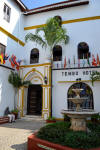 |
 |
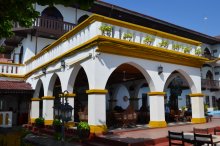 |
 |
Breakfast in the hotel's 5th-floor restaurant featured a reasonably attractive spread and very friendly service from the staff. We had pre-booked onto a walking tour of Stone Town with tour company Zanzibar Different, and met our guide Anjam in the hotel lobby at 9:30. The first order of business was a short walk to the nearby Tembo House Hotel to pick up an American family of three, in which the adult daughter was serving in Zambia with the Peace Corps. We learned that Anjam was scheduled to be our guide for the next three days, with the American family once again joining us on Wednesday.
The tour began with a visit to two nearby points of interest, both separated from the seafront by the Forodhani Gardens: the 17th-century Old Fort of Zanzibar, built by the Omanis to repel a Portuguese attack, and the House of Wonders, built in the late 19th century by the second Sultan of Zanzibar.
 |
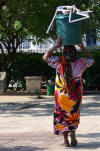 |
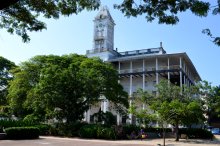 |
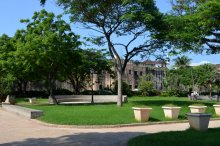 |
 |
|||
| Forodhani Gardens | House of Wonders | Old Fort of Zanzibar | |
Anjam then led the group off in the direction of Kenyatta Road and the Shangani district. As we walked, we were starting to see examples of typical architectural features such as large verandahs protected by carved wooden balustrades, and wooden doors with brass studs in the Indian tradition. Although UNESCO World Heritage Site designation helps protect the area, the trade-based wealth of years gone by is no longer there and sadly, around 80% of the buildings are listed as 'deteriorating'. We stopped at a house purporting to be the birthplace of one Faroukh Bulsara (1946-1991), although in reality the exact location of his arrival into the world is not known. He was much better known to most people as Freddie Mercury, lead singer of rock band Queen.
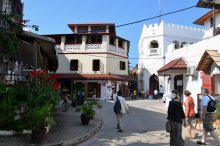 |
LEFT: Anjam leads the group away from the seafront towards the Kenyatta Road |
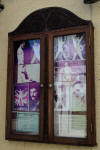 |
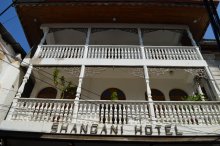 |
| RIGHT: Mercury House and the Shangani Hotel |
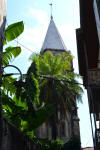 |
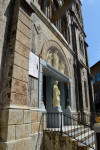 |
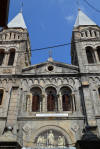 |
| St Joseph's RC Cathedral | ||
Although Zanzibar is more than 90% Muslim, it has enough of a Christian population to support two cathedrals, and there is also a small Hindu community. The first of the two great Christian churches, St Joseph's RC Cathedral, formed our next brief stop. Next followed one of the most interesting parts of the tour, where we wandered around a maze of narrow lanes and got more of a taste of local Stone Town life and everyday commerce. There were some colourful displays of various fabrics and other goods for sale, which together with the architectural features made for plenty of visual interest.
 |
 |
 |
 |
 |
 |
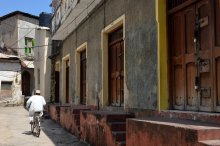 |
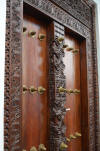 |
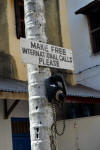 |
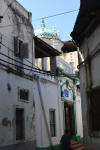 |
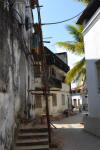 |
|
The colourful theme continued as we progressed to geographically the easternmost point on the tour, the bustling Darajani Market. The strength of the midday sun was obvious as we emerged from the narrow streets and lanes into this more open location.
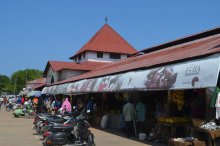 |
 |
 |
 |
 |
 |
 |
 |
 |
The final sightseeing stop was Christ Church Anglican Cathedral, a site of major historical importance as the cathedral is built directly on the location of what was once Zanzibar's largest slave market. The cathedral itself was constructed mostly of coral stone and opened in 1903. It was undergoing extensive renovation works at the time of our visit, affecting both the interior and exterior of the building. As a Scot, I was particularly interested to read of the role that explorer David Livingstone had played in ending the slave trade in Zanzibar.
 |
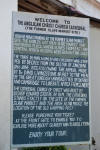 |
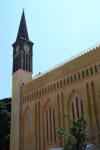 |
LEFT: Christ Church Cathedral, undergoing extensive cleaning and renovation |
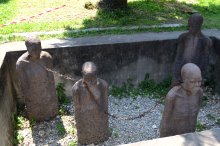 |
 |
RIGHT: Memorial to the victims of the slave trade |
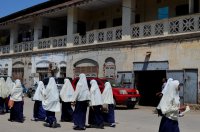 |
| School's out! |
After seeing the colourful and interesting sights
of Stone Town on foot, it now quite definitely felt like lunchtime.
We knew that the tour involved having lunch with a local family, but
the absolute highlight of the day came when the family concerned
turned out to be that of Anjam, our guide. We were guests at his
house for a lovely meal served by his charming wife, and we were
also joined by his daughter, who was home from school for lunch. Of
the many treats on the table, the highlights were a fish curry,
grilled fish steaks and very tasty beans in sauce. Our hostess was
nervous in case her food might not be good enough, until Anjam
pointed out to her that Bruce and I were already on our second
plateful! The whole experience was thoroughly enjoyable,
highlighting the fact that travel is about more than sightseeing.
Let's face it: it's not every day that somebody from Central
Scotland finds himself on a
beautiful island off the east coast of Africa, eating lunch as a
guest in the home of a local Muslim family. If this was anything to
go by, our chosen local tour company, Zanzibar Different,
was genuinely living up to the promise implied by the second half of
its name.
![]()
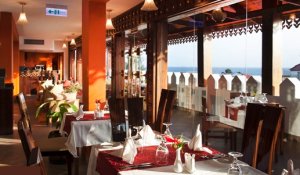 The
tour had overrun substantially, but no-one minded in the least. We
got back to the DoubleTree around 3:20 and spent the rest of the
afternoon just lazing around - a perfectly reasonable thing to do on
holiday!
The
tour had overrun substantially, but no-one minded in the least. We
got back to the DoubleTree around 3:20 and spent the rest of the
afternoon just lazing around - a perfectly reasonable thing to do on
holiday!
Conscious that we had another full-day tour ahead of us on Tuesday, we didn't feel like venturing out in the evening; instead, we returned to the hotel's top-floor restaurant for drinks and a light evening meal. What a fabulously interesting and enjoyable day it had been!